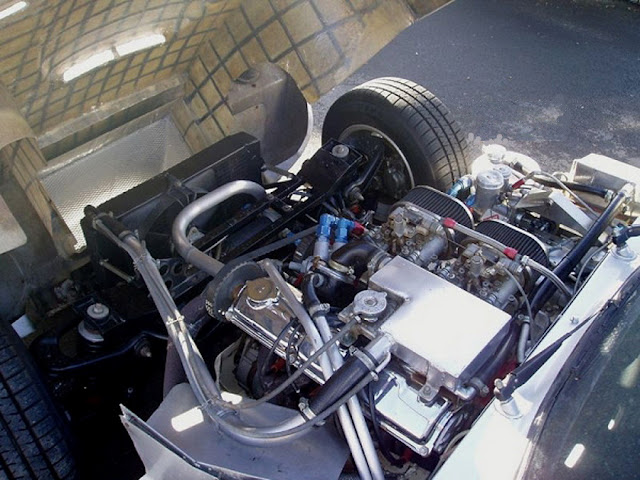Frank Costin's Amigo
As the development of aviation in the early 20th century accelerated, so did the scientific theory and understanding of aerodynamics. The war years raised the stakes even higher as aircraft technology grew in leaps and bounds. Among the pioneers of the field was an Englishman named Frank Costin. Costin was born in Middlesex, England, in 1920. In his youth, he was an Olympic-level competitive swimmer and developed a passion for mathematics at an early age.
His career started as the second World War began, finding him getting involved in the aviation industry. This stage of his career included working with Supermarine, Percival and de Havilland, including an important spell as an airframe flight-test engineer in charge of the experimental department at their Chester division. However, by the late 1950's the industry was in decline and by 1958, Costin had moved on.
 |
| Costin, with his prototype Marcos Xylon marine plywood chassis |
Like many young men in post-war England, he got involved with motorsports during the 1950's and 60's. He became a "Household Name" in the UK for his work on the Vanwall Grand Prix racecar, but he was also known for work on the Lotus 11 as well as various cars for Lister, TVR, and his partnership with racecar builder Jem Marsh in the form of "Marcos", which was a combining of their respective surnames. It was during his time with Marcos that Costin developed the signature method of construction found in most all of his subsequent automotive creations but his involvement in the marque would only last through its first few years.
Having parted ways with Jem Marsh and Marcos, Costin decided to produce a road car entirely of his own conception. This was to be the "Amigo" and it was his most sophisticated feat of design yet. Designed in 1968, It employed an evolved form of wooden stressed-skin hull chassis with an incredible degree of rigidity. He designed the tub around six torsion boxes. Three ran fore and aft and consisted of deep sills on either side of the cockpit and the transmission tunnel. The sills were strengthened by internal bulkheads, or ribs, placed at 12″ intervals. Three more torsion boxes ran transverse to the structure, one forming the engine bay, the next the cockpit, and the last the trunk and rear suspension housing. A fully enclosed stressed undertray tied all of the boxes together.
The skin consisted of marine plywood and spruce. The internal bulkhead, local reinforcement for suspension pickups, and all major stressed structures were constructed of non-marine plywood and Parana pine. All bonds were made with a synthetic resin adhesive called Aerolite, which required minimal clamping pressure to set, because of its excellent gap-filling properties. Thus, the production jigs were maintained by simple spring pressure or C clamps.
The chassis featured built-in seats, which were essentially multi-curved sheets of plywood. They were internally boxed and glued to the primary structure as well, which contributed to its overall rigidity. To accommodate a given driver, the steering wheel and pedal group were movable as a unit, fore and aft. They were mounted on a tracked assembly that was spring loaded towards the rear and was operated via a pull knob on the dash.
The front-hinged hood and coupe top were constructed of fiberglass. A thin fiberglass veneer was also applied to all of the exterior wood surfaces of the body and doors in order to produce a smooth enough surface for accepting a top-quality paint job.
Door hinges on a wooden monocoque presented all manner of problems to Costin, but the most reliable, easily maintained and adjusted, proved to be a pair of exterior mounts. These were paired with low drag covers, the top ones incorporating cockpit air intakes that fed air to vents above the door sills.
It employed an advanced, low drag body with a "coke bottle" shape that enhanced straight-line stability. No detail was ignored and even the mirrors were wind-tunnel tested. The ultra lightweight construction and streamlined shape of the Amigo helped it achieve more than 130mph, despite using a basic 2.0 liter Vauxhall motor. Its rigidity and low center of gravity made for great handling too.
Sadly only 8 were made because the financial backing that Costin secured to cover the construction of prototypes could not be extended to permit the car to go into production and so the project ended.
Costin's work continued, designing various prototypes and racecars including the Costin Sports Roadster, an ultra-light glider called the Dragonfly, the TMC Costin kit car, and a Formula Ford racer.
Francis Albert Costin passed away in 1995, at the age of 75. He leaves a rich legacy of creativity behind him.
Learn more about this amazing and innovative man here on RCC.
Sources:
Moss Motoring
Moss Motoring
Image Credits:
Ian Tompsett
Ian Tompsett



















Termites and woodpeckers, oh my!
ReplyDelete